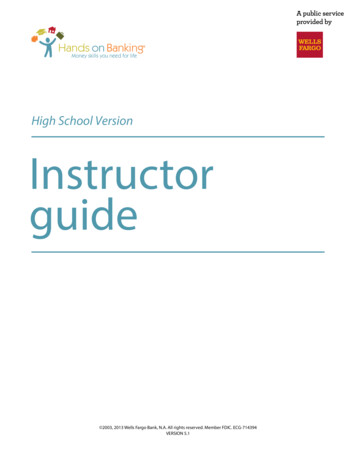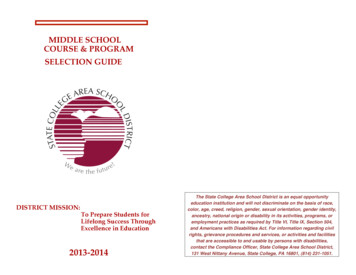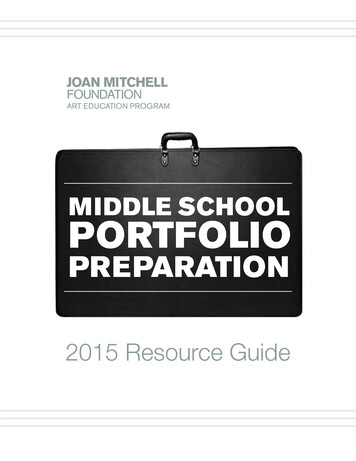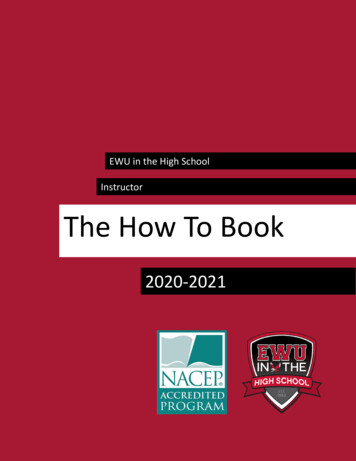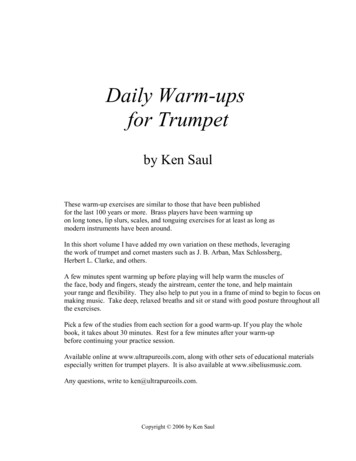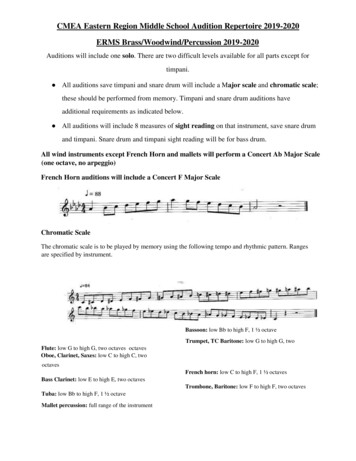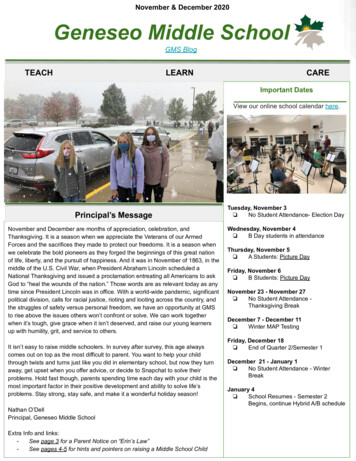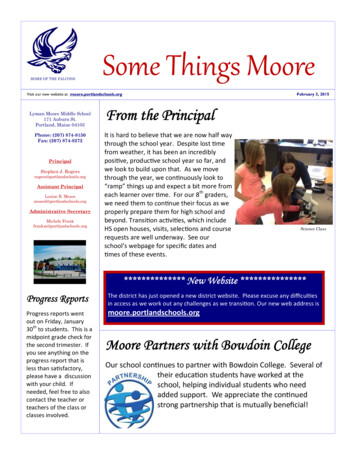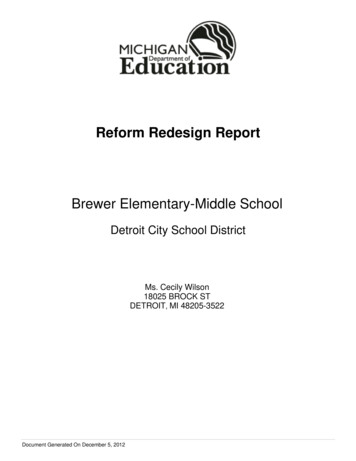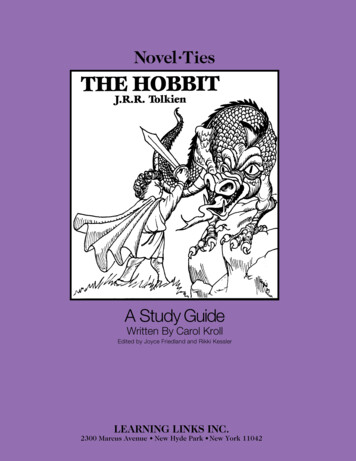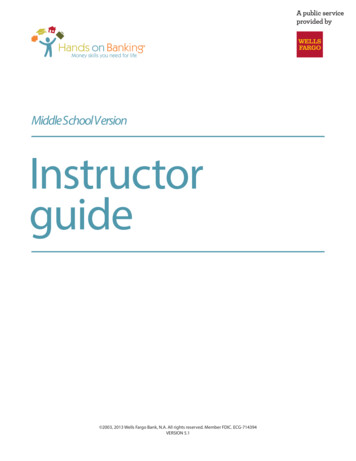
Transcription
Middle School Version.Instructorguide. 2003, 2013 Wells Fargo Bank, N.A. All rights reserved. Member FDIC. ECG-714394VERSION 5.1
Hands on Banking Instructor’s Guide.Middle School Version (Grades 6–8).Table of Contents.Introduction4.How to Use This Guide6.You and Your Money9.Unit Overview9.Section 1: Money and Banking10.Section 2: Value14.Section 3: Earning Power17.Teaching Tips18.Budgeting20.Unit Overview20.Section 1: Understanding and Creating Budgets21.Section 2: Using a Budget31.Teaching Tips39.Savings and Checking Guide42.Unit Overview42.Section 1: Savings Accounts43.Section 2: Checking Accounts59.Section 3: Balancing a Bank Account64.Teaching Tips69.Credit and You72.Unit Overview72.Section 1: Credit and Credit Cards73.Section 2: Loans78.Teaching Tips79.HANDS ON BANKING INSTRUCTOR GUIDE TEENS VERSION 5.1 2003, 2013 Wells Fargo Bank, N.A. All rights reserved. Member FDIC www.handsonbanking.orgPage 2 of 115
Hands on Banking Instructor’s Guide.Middle School Version (Grades 6–8).Table of Contents.Smart Investing81.Unit Overview81.Section 1: Introduction to Investing82.Section 2: Capital Gains and Losses87.Teaching Tips90.Assessment92.Additional Student Activities98.Proposing a Budget98.Glossary, Common Core Standards, and CertifcateHANDS ON BANKING INSTRUCTOR GUIDE TEENS VERSION 5.1 2003, 2013 Wells Fargo Bank, N.A. All rights reserved. Member FDIC www.handsonbanking.orgPage 3 of 115111.
Introduction.The Hands on Banking program is an interactive fnancial-literacy curriculum for students grades 4-12 and adults. Thisteacher’s guide is designed for the Kids’ (grades 4 and 5) curriculum of the program.The Hands on Banking program was developed to teach both the basics of good money management and the skillsneeded to create a brighter fnancial future. The lessons examine fnancial concepts and decision-making through illustration, real-life problems, and mathematical computation. The curriculum is relevant to students’ lives, and is designedto support their fnancial success.This fun and innovative program was developed by Wells Fargo as a free community service. It is intended for educational purposes only and contains no commercial content.The Hands on Banking program is available free of charge in both English and Spanish, both on the Web(at www.handsonbanking.org and www.elfuturoentusmanos.org) and on CD-ROM. The curriculum is designedfor self-paced, individual learning or for classroom use.This teacher’s guide is designed to be used alone or as an adjunct to the online program.Educational standards.The lessons in this program adhere to the following mathematics and fnancial literacy standards: National Council of Teachers of Mathematics (Principles and Standards for School Mathematics, 2000) National Council of Economic Education and the National Association of Economics Educators and the Foundation for Teaching Economics, Voluntary National Content Standards in Economics (1997) JumpStart Coalition for Personal Financial Literacy, National Standards in K–12 Personal Finance Education (2007)Common Core State Standards (2017 update)This guide has been updated with lessons and activities that meet the Common Core State Standards in both mathematics and Englishlanguage arts. A crosswalk and listing of lessons and activities is included in the Appendix.Teachers are encouraged to integrate the content into other lesson plans, and use the curriculum as a springboardto address real-life situations.Please refer to your own state, local, district, or school standards to determine the appropriateness of the lessonsfor your students.The No Child Left Behind Act is a federal law designed to improve the academic achievement of all students, particularly those who are minorities, disabled, economically disadvantaged, or have limited English proficiency. TheAct requires teachers of mathematics to provide all students with equal opportunities to excel and themathematical skills and knowledge they need to actively participate in American society. Consistent with theobjectives of the No Child Left Behind Act, the Hands on Banking / El futuro en tus manos curriculum andsupplemental materials for grade levels 4–12 are aligned with both state and national educational standards formathematics, reading, and economics.HANDS ON BANKING INSTRUCTOR GUIDE TEENS VERSION 5.1 2003, 2013 Wells Fargo Bank, N.A. All rights reserved. Member FDIC www.handsonbanking.orgPage 4 of 115
Curriculum overview.The online Teens’ Hands on Banking curriculum is divided into fve units, plus an assessment. Each unit contains multiple lessons. The teacher’s guide condenses each online unit’s lessons into a smaller number of sections. The lessonsin this guide contain activity worksheets for you to use with your students.This curriculum is designed to be presented in the given lesson sequence. However, depending on what is appropriatefor your students, you may wish to establish your own sequence.Problem solving is woven into all of the program’s units. Students apply both their understanding of basic banking concepts as well as strategies to solve challenging problems in diferent contexts.To be successful with the Hands on Banking curriculum, students should be able to: Perform basic functions on a calculator Read profciently at a level commensurate with their grade level Follow basic written and oral directions, and readily understand oral dialogueBecause students’ mathematical skills vary, teachers should review the problems in this guide before having studentsuse the Hands on Banking Web site.To request a free CD-ROM.To request a CD-ROM for your classroom, please contact us via email at HOBCD@wellsfargo.com. The CD-ROM contains both the English and Spanish versions of the program for all age groups. There is no charge for small quantities ofthe CD-ROM. Please call for information regarding high-volume requests. Please allow two weeks for delivery.Your thoughts are welcome.We welcome your comments and suggestions for future versions of the Hands on Banking curriculum and this teacher’sguide. Please contact us via email at HOBinfo@wellsfargo.com.Thank you for sharing these valuable fnancial literacy programs with students and adults in our communities. As a teacher,your training and guidance will provide others with the knowledge and skills they need for a brighter fnancial future!The Hands on Banking program is sponsored and developed by Wells Fargo to serve our communities. The productsand services mentioned are those typically ofered by fnancial institutions and do not represent the specifc termsand conditions of Wells Fargo’s products and services. The site contains no advertising and does not require or collectany personal information.HANDS ON BANKING INSTRUCTOR GUIDE TEENS VERSION 5.1 2003, 2013 Wells Fargo Bank, N.A. All rights reserved. Member FDIC www.handsonbanking.orgPage 5 of 115
How to Use This Guide.The purpose of this teacher’s guide is to support the efective presentation of the Hands on Banking curriculum in yourclassroom. As a frst step, we strongly encourage you to review the program online (at www.handsonbanking.org andwww.elfuturoentusmanos.org. Even if your students will not be using computers at school, gaining familiarity withthe program will help you present it more efectively.Five ways this guide can help you.This teacher’s guide is designed to be used alone or as an adjunct to the online program. If you’re a teacher or groupleader, this guide can help you in fve ways:1. Gain familiarity with the program: Reviewing this guide is a convenient way to familiarizeyourself with the Kids’ curriculum if you do not have ready access to a computer or the Internet.2. Prepare lessons: If your students will not have access to computers, you can use this teacher’sguide as a resource for preparing your lesson plan.3. Utilize worksheets: The teacher’s guide includes activity worksheets which allow your students to apply what they have just learned to real-life scenarios. A teacher’s copy of each worksheet, including answers and hints, follows the students’ worksheet.4. Extend or modify lessons: The guide features suggested teaching tips. Use these additionalactivities to extend or modify the unit objectives to best meet the needs of your students.5. Assess progress: Finally, this guide includes an assessment that students can use to test theirknowledge.How the guide is organized.This guide covers four units, followed by an assessment and a dictionary of fnancial terms. The Hands on Banking curriculum is designed to be presented in unit and lesson sequence. However, depending on what is appropriate for yourstudents, you may use this guide to establish your own sequence. You may choose to present individual units or lessonson a stand-alone basis, or in diferent combinations, based on your specifc educational objectives.Each unit of this guide adheres to the following format: Unit Overview.A summary of the unit’s content. Learning Objectives.The specific financial-literacy and mathematical objectives of the lessons. Alignment with Educational Objectives.The financial literacy, English language arts, and mathematics standards, by grade level, to whichthese lessons are aligned.HANDS ON BANKING INSTRUCTOR GUIDE TEENS VERSION 5.1 2003, 2013 Wells Fargo Bank, N.A. All rights reserved. Member FDIC www.handsonbanking.orgPage 6 of 115
Sections.A grouping of related Hands on Banking lessons. Each individual section includes:Opening Questions.Questions to start your students thinking about the concept and how it relates to them.Key Points.A series of bullet points summarizing critical concepts. Please note that this portion of the guidefrequently includes extra information to complement and enrich what is ofered in theonline/CD-ROM version of the Hands on Banking program.Activities.Indicates that a worksheet follows.Student worksheet.These worksheets allow your students to apply what they have just learned to real-life scenarios.Teacher’s copy of Worksheet.A teacher’s copy of each worksheet, including answers and hints, follows the students’ worksheet. Thestudents’ copy can be duplicated or made into an overhead transparency for a whole-class activity.Teaching Tips.Use these additional activities to extend or modify the unit objectives to best meet the needs of yourstudents.About content modifcations.Please note that in some cases the content of the teacher’s guide has been modifed from the onlineprogram. (For example, the online lesson may ask students to use a calculator, ATM simulator, orcomputerized worksheet—features that are available to only those students using a computer.) Inthese cases, a modifcation icon appears in the teacher’s guide. Watch for this icon—it will quickly alertyou to any content that difers from the online curriculum.About the narrators.The online narrators of the Middle School Version of the Hands on Banking program are Angie andAlex, two outgoing, money-savvy teenagers. Alex and Angie share with other teens what theyhave learned about managing money.HANDS ON BANKING INSTRUCTOR GUIDE TEENS VERSION 5.1 2003, 2013 Wells Fargo Bank, N.A. All rights reserved. Member FDIC www.handsonbanking.orgPage 7 of 115
Prepare yourself—and your students.Prepare your students for a positive learning experience with the Hands on Banking program: Know the program. Get familiar with each unit and its lessons. If possible, review the program online. Review the math concepts. Before assigning students to work on any unit, review with them theunderlying mathematical concepts needed for problem solving. Be sure your students are able todo the necessary level of computation before they begin. Introduce fnancial vocabulary. Be sure your students gain a working understanding of new fnancialterms. Key terms, shown in boldface, appear in the dictionary at the back of this guide. Prepare for work. Encourage students to bring a calculator and pencil and paper to work through themath, whether or not they are at a computer. Encourage collaboration. Allow students to work in pairs on the worksheet problems. Encouragethem to share their approaches to fnding the solutions. Promote discussion. Discuss the examples with your students. Talk through the problems and howto arrive at the solutions. Math problems in the online/CD-ROM program provide both answers andhints to arrive at the solutions. This guide provides hints and answers only on the teacher’s copy ofeach activity. Use the teaching tips. Refer to the teaching tips found at the end of each unit in this guide to modifyand extend the new ideas presented in the Hands on Banking curriculum.If your students are using computers. Review the basics of computer literacy. To be successful, students should be able to work with a mouse (toscroll, highlight, and drag and drop words and numbers) and enter an answer on the screen. Orient students to the site. Help students explore how to navigate the program and access its primaryfeatures . Use the computerized calculators. Introduce students to the basic calculator featured on the Web siteand CD-ROM. It can be accessed by clicking the Tools button. Take advantage of on-screen hints. With an incorrect answer to a problem, students may be shown ahint automatically. Encourage ATM practice. Introduce students to the ATM simulator, which can be accessed by clickingthe Tools button. Use the Glossary. Teach students how to access the glossary of fnancial terms, which can be accessedfrom each page. Key terms are shown in boldface in the site’s closed-captioning.After studying the curriculum. Encourage students to take the assessment. Students may use the assessment to test their knowledge ofthe Hands on Banking curriculum for their specifc age group. The teacher’s copy of the assessment, including hints and answers, follows the students’ worksheet. Ask students to complete the assessment after they have studied the curriculum. Students should usetheir incorrect answers to identify areas for review, and following a review, take the assessment again. If using the online or CD-ROM versions of the Hands on Banking program, the program will automatically score the results. For a score of 70% or higher, students can print out a certifcate of achievement,personalized with their names. If you are not online or using the CD-ROM, a certifcate of achievementtemplate is included for photocopying.HANDS ON BANKING INSTRUCTOR GUIDE TEENS VERSION 5.1 2003, 2013 Wells Fargo Bank, N.A. All rights reserved. Member FDIC www.handsonbanking.orgPage 8 of 115
You and Your Money.Unit Overview.In these lessons for middle-school students (grades 6–8), we reinforce the concept that money is earned and usedto buy things. Students explore the meaning of “buying power” in order to make sound decisions about their ownspending. Students also review the basic purposes of banks and banking. Finally, students consider how their education, skills and career choices may infuence their income. At the end of these lessons, students will be able to identifythe real buying power of earnings and money, and the role banks and other fnancial institutions can play in assistingpeople to manage their money wisely.In the online/CD-ROM version of the Hands on Banking program, there are eight lessons that are condensed intothree sections, below.Section 1: Money and Banking.What is money, how is it used in our society? What roles can banks and other fnancial institutions play in helpingyou to manage your money?Section 2: Value.Money has value, and individuals can make choices about how, when and where to spend their money to receivethe most in return.Section 3: Earning Power.An individual’s education, skills, and career choices infuence his or her income.Learning Objectives.The fnancial-literacy objectives of these lessons are for students to identify sources of income, recognize the importance of money in society, and describe the role of banks.The mathematical objectives of these lessons are for students to do mathematical computations in the process of solving real-life mathematical problems.Alignment with Educational Standards.National Council of Economic Education and the National Association of Economics Educators and the Foundationfor Teaching Economics, Voluntary National Content Standards in Economics (1997), Grade 8: Content Standard 10: “Describe the roles of various fnancial institutions. Banks and other fnancial institutions channel funds from savers to borrowers and investors.” Content Standard 11: “Money makes it easier to trade, borrow, save, invest, and compare thevalue of goods and services. As a store of value, money makes it easier for people to save anddefer consumption until the future. As a unit of account, money is used to compare the marketvalue of diferent goods and services.”JumpStart Coalition for Personal Financial Literacy, National Standards in K-12 Personal Finance Education (2007),Grade 8 Standards: Financial Responsibility and Decision Making; Income and Career.National Council of Teachers of Mathematics Principles and Standards for School Mathematics, (2000), Grades 6–8: Number and Operations Expectations: “ work fexibly with fractions, decimals, and percents tosolve problems.” Problem-Solving Expectations: “ solve problems that arise in mathematics and in other contexts; apply and adapt a variety of appropriate strategies to solve problems.”National Governors Association Center for Best Practices and Council of Chief State School Officers (2010).Mathematics and English language arts content standards.HANDS ON BANKING INSTRUCTOR GUIDE TEENS VERSION 5.1 2003, 2013 Wells Fargo Bank, N.A. All rights reserved. Member FDIC www.handsonbanking.orgPage 9 of 115
Section 1: Money and Banking.What is money, how is it used in our society, and what roles can banks and other fnancial institutionsplay in helping you to manage your money?Opening Questions:Use these or similar questions to start students thinking about this concept and how it relates to them: Does anyone know where money comes from—how is money producedoriginally? What are some of the reasons that people use banks? What are some examples of how money changes hands in our society? Whatmakes money fow between people, businesses, and banks?Key Points.Money and how it is used. Money is how we measure economic value. The cash and coins we use, calledcurrency, are what we use in our society to pay for goods and services. Most countries create their own currency. In the U.S., the federal governmentprints money and regulates the amount. In North America alone, severalforms of currency are in use: the Canadian dollar in Canada, the U.S dollar inthe U.S., and in Mexico, the peso. All the coins and bills in the U.S. are created, or “minted,” by the Treasury ofthe federal government. The Treasury carefully controls how many dollars andcoins are distributed. Money is the glue that binds products, services, and people together in oureconomy. Our country’s economic engine is fueled by what people create,and money allows people to both produce and buy what is created. People earn money by working and being paid for their work. Aside from being fun to have, money helps you handle the necessities ofeveryday life. Money changes hands frequently—it’s exchanged everyday between people,businesses and banks. Money may come to a bank from many sources. It starts at the Treasury, whichkeeps banks supplied with the money they need for their customers. Butmoney that’s already in the economy also goes to banks—from individualsand businesses who keep their money in banks. People put their money in a bank for safekeeping. Banks pay interest on themoney people put in the bank for extended periods of time. Banks lend the money to borrowers and investors. Banks charge interest on themoney they lend. Money leaves the bank, goes through the economy, and comes back again.Money recy
Hands on Banking program is an interactive fnancial-literacy curriculum for students grades 4-12 and adults. This teacher’s guide is designed for the Kids’ (grades 4 and 5) curriculum of the program. The . Ha

